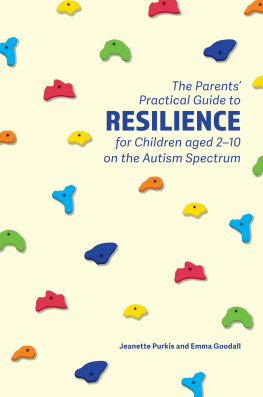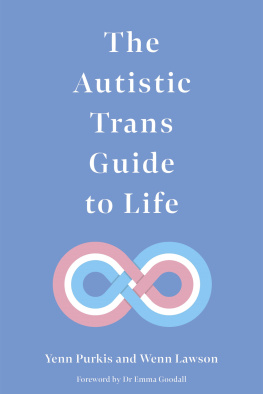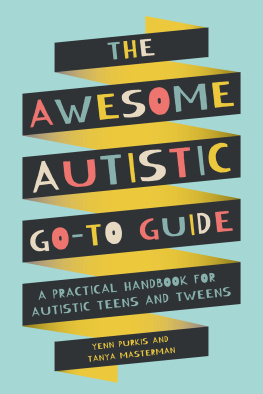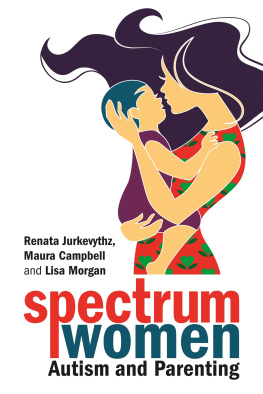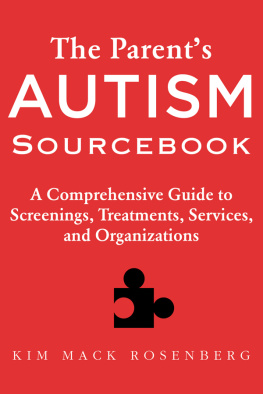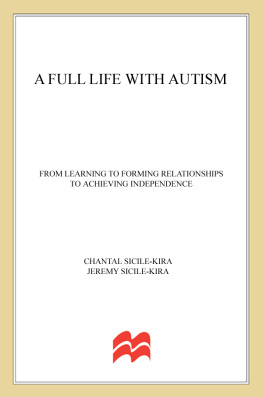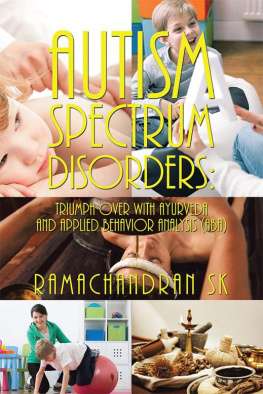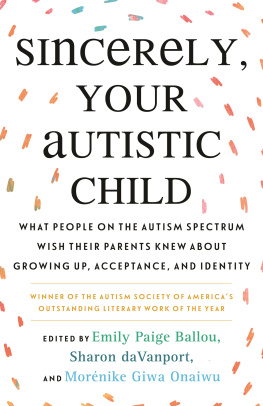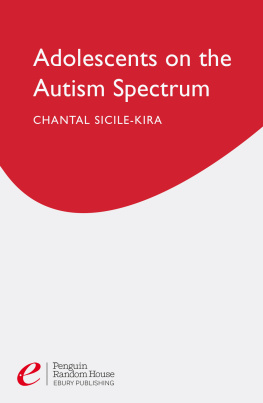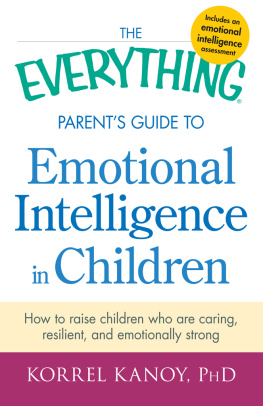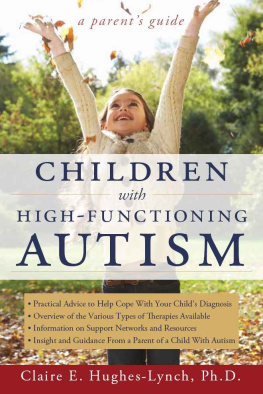
The Parents Practical Guide to
RESILIENCE
for Children Aged 210
on the Autism Spectrum
Jeanette Purkis and Emma Goodall

Jessica Kingsley Publishers
London and Philadelphia
CONTENTS
INTRODUCTION
This book came about because Emma Goodall, one of the authors, heard the following story from the other author, Jeanette Purkis, and thought about it, in that very autistic way of revisiting and revisiting the story over and over. Emma then phoned Jeanette and said, I think we should write a workbook for parents, to teach their autistic children and teens to be resilient.
In 2012, I met a young man who had been diagnosed with Asperger syndrome when he was 6 years old, Adam. anxiety of parents who have been told throughout their childs life about all the challenges and deficits that come with autism and few or none of the positives. I really felt for Adam and wanted to address this issue somehow, for surely there were many more autistic young people in a similar situation. (Jeanette Purkis)
Adams story is one of the many things that inspired this book, as it caught Emmas attention due to her passion for ensuring that other autistics are on a path to a good life. The story demonstrates the need for resilience in autistic young people. Resilience is essential for navigating the adult world and being a fulfilled person who can reach their potential. Both Emma and Jeanette can be seen as successful autistic adults, in that they both work and live in their own homes (with fur and human family). However, underneath that veneer, both women are still autistic and still struggle with sensory and communication differences in a non-autistic world. It is their resilience and drive to make a difference that enable them to learn from mistakes and move forward, even if that learning can take decades at times!
One of the challenges around the autism diagnosis is that it can unintentionally lead to dependence and a lack of resilience and confidence in autistic children and young people, as is evident from Adams story. The diagnosis which should ideally be liberating and empower the autistic person to understand and value their unique experience of the world can sometimes, sadly, result in dependence and disengagement. A focus on deficits and perceived incompetence and messages given to a child can result in autistic children and young people doubting themselves and being unable to take on challenges. Building independence and resilience is a great way to address this.
Several factors probably influenced Adams challenges and lack of independence. Adams story, however, is far from inevitable. Autistic children and young people have the capacity to be independent and resilient. Building resilience and independence in autistic children can start at a very young age. The earlier the process of building resilience starts, the better. This book aims to empower parents of autistic children to help them promote resilience in their child. Independence can be taken to mean able to live independently or requires support to live a fulfilling life. Being verbal is not a prerequisite for either of these, and many adults who do not use speech live happy and fulfilling lives.
If a parent thinks their child may be autistic, or even if they think they may not be, this book will be a useful tool for teaching resilience. All the activities are based on over fifteen years of teaching and education consultancy experience, as well as having been audited by a variety of different autistic adults and parents to ensure the activities are beneficial.
This book is a practical, activity-based resource for parents of autistic children aged between 2 and 10 years. It is focused on guiding parents to build the foundations of resilience and independence in their children. The book provides parents with information on resilience and the main developmental stages for children on the autism spectrum aged from 210 years of age. The book will take you through life events and milestones at different ages and identify where difficulties and barriers to resilience may arise and how to address them. Each life event will include exercises that you can work through in order to more effectively build resilience and independence in your child. The information will help you understand what your child might be experiencing so as to enable you to better assist them through their life journey.
This book aims to enable you to promote resilience in your child. It is written from a strengths-based approach to autism and the view that autistic people interpret and engage with the world in a way that is different rather than deficient. Building resilience can set up autistic children to navigate through life better and build their self-esteem and confidence. Resilience building at young ages can have a significant impact on childrens ability to successfully navigate life in adulthood and will help them to find their place in society and reach their potential as adults when the time comes.
The book will take you through what resilience is, why it is needed, what the risk factors and protective factors are around resilience in children on the autism spectrum, as well as the challenges for children on that spectrum. It will work through a number of life events that children generally experience, including trying new foods, visiting relatives, meeting other children, going to pre-school, managing being told No!, sharing with others, going to the doctor, learning new motor skills, starting school, changes at school, social interactions, losing a game, responding resiliently to bullying, going to the dentist, sleepovers, school camp and managing emotional distress.
Each life event will include helpful information and activities to enable you to guide your child through the event successfully and build their strength and confidence. The book will include information on how to ascertain where the child is at in terms of their resilience. There are also performance indicators showing what a good outcome at each life stage might look like for your child. There is also a chapter on failing successfully. Being able to manage failure is an essential life skill for everyone, and particularly for autistic kids who may be anxious around failure and mistakes.
Meltdowns and shutdowns are mentioned throughout this book. An autistic meltdown or shutdown occurs when an autistic person is overloaded, either with emotions, social input, sensory stimuli, anxiety or other overwhelming experiences. A shutdown is an internalising response to being overwhelmed and a meltdown is an externalising response. Both of these are unintentional behaviour, which is almost impossible to control. Autistic people including children do not have meltdowns intentionally, and they generally feel very bad that a meltdown has occurred. Meltdowns and shutdowns are very different from a tantrum, which occurs when a child wants their own way but is not being allowed to have their own way.
While some of the events in this book list decreasing meltdowns as an indicator that your child is doing well, it does not follow that a meltdown is poor behaviour. A meltdown is an indicator of overload rather than poor behaviour. Building resilience and confidence in an ever-increasing range of environments and activities helps to minimise the frequency of autistic meltdowns. Over time, many autistics develop the ability to cope with new or challenging situations, with resultant meltdowns happening later when the autistic is in a safe place, such as at home after school or work. However, without resilience and confidence, even adults struggle to manage their meltdowns.
Next page
